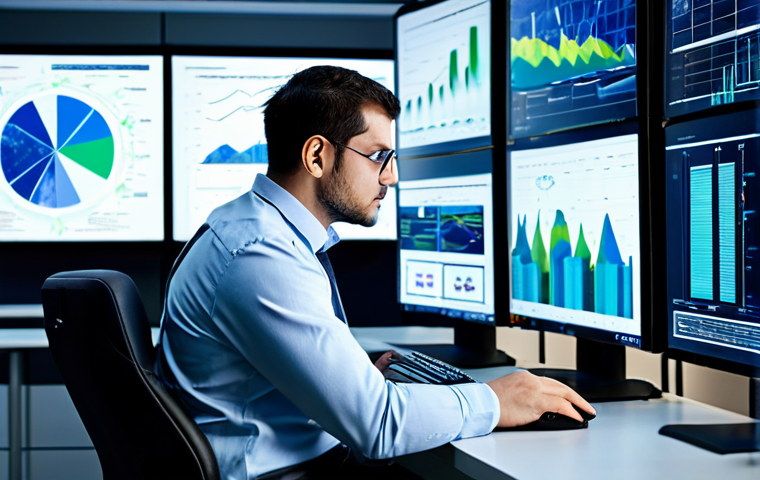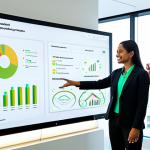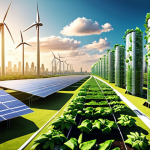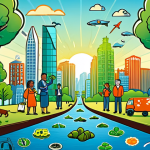Just a few years ago, when I first dipped my toes into the world of sustainability, it felt like a niche, primarily confined to environmental science and conservation.
But wow, has that landscape dramatically shifted! It’s no longer just about saving pandas or planting trees, important as those things are. The truth is, the very fabric of our global economy and society is now demanding a deeper, more integrated approach to sustainability.
I’ve personally seen how professionals in this field are no longer bound by traditional job descriptions. They’re becoming architects of change in finance, tech, urban planning, and even fashion.
From pioneering regenerative agriculture techniques to advising corporations on intricate ESG frameworks, the pathways are exploding. Latest insights suggest that the future of work heavily leans into these “green collar” roles, with AI and data analytics playing an increasingly critical part in identifying sustainable solutions and optimizing resource use.
We’re witnessing a fascinating convergence where purpose meets profit, driven by urgent global issues. It’s clear that the journey for a sustainable development expert today is anything but linear; it’s a dynamic exploration of interdisciplinary frontiers, pushing boundaries we didn’t even know existed.
We’re talking about shaping economies that thrive within planetary boundaries, and for that, we need nimble, innovative minds. Let’s dive deeper below to uncover more about these incredible opportunities.
The Shifting Sands of Sustainable Careers: Beyond Greenwashing

I remember a time, not so long ago, when “sustainability” in a job description often meant you were either an environmental scientist in a lab coat, a conservationist knee-deep in a swamp, or perhaps someone working on corporate social responsibility as a side project.
Oh, how times have changed! Today, the definition of a sustainable career has exploded into a kaleidoscope of roles that are deeply embedded in the core functions of businesses, governments, and communities worldwide.
It’s no longer just about ticking a box; it’s about fundamentally rethinking how we operate, how we produce, and how we consume. I’ve personally witnessed friends and colleagues, who started in seemingly unrelated fields like finance, engineering, or even marketing, pivot and flourish in sustainability roles, bringing their unique skill sets to bear on pressing global challenges.
This isn’t just a trend; it’s a foundational transformation, driven by consumer demand, regulatory pressures, and an undeniable understanding that our planet’s health directly impacts our economic viability and social stability.
We’re talking about roles that demand critical thinking, interdisciplinary collaboration, and an unwavering commitment to long-term impact over short-term gains.
It’s exhilarating, challenging, and profoundly rewarding to be part of this movement.
1. From Niche to Core: Integrating Sustainability Across Industries
The most striking shift I’ve observed is how sustainability has moved from the periphery to the very heart of diverse industries. Think about it: once, a fashion brand might have had a small team looking into ethical sourcing, but now, entire supply chains are being redesigned with circularity and fair labor practices at their core.
In finance, ESG (Environmental, Social, and Governance) factors are no longer just an ethical consideration but a critical part of risk assessment and investment strategy, profoundly impacting valuations and investor decisions.
Even in the tech sector, which once focused solely on speed and scalability, there’s a massive drive towards sustainable data centers, energy-efficient algorithms, and technology that actively supports climate resilience and resource optimization.
This isn’t just about adding a “green” label; it’s about deeply embedding sustainable principles into every process, every product, and every strategic decision, transforming the very DNA of these industries from within.
It requires professionals who can speak the language of business, but with a deep understanding of ecological and social impacts, bridging what were once disparate worlds.
2. The Interdisciplinary Imperative: Blending Expertise for Impact
What truly excites me about this field is the sheer diversity of backgrounds that are now converging. You see urban planners working hand-in-hand with ecologists, data scientists collaborating with social justice advocates, and engineers partnering with economists.
It’s a beautiful, messy, and incredibly effective fusion of disciplines. For instance, I recently spoke with a former architect who now specializes in designing “biophilic” buildings that not only minimize environmental footprint but also enhance human well-being through natural light, ventilation, and green spaces.
Another friend, a former supply chain manager, is now designing reverse logistics systems for electronics, ensuring valuable materials are recaptured and repurposed, not simply discarded.
This blending of expertise means that no single degree or background is the “right” one. Instead, it’s about a willingness to learn, adapt, and collaborate across traditional boundaries.
The problems we face are complex and interconnected, and the solutions, by necessity, must be too. This makes the learning journey continuous and endlessly fascinating.
Navigating the Corporate Compass: ESG and Stakeholder Engagement
When I first heard the term “ESG,” I honestly thought it was just another piece of corporate jargon, a fancy acronym that would fade away. But, boy, was I wrong!
ESG has rapidly evolved from a buzzword into a formidable framework that is fundamentally reshaping corporate strategy, investment decisions, and even consumer behavior.
It’s no longer just about “doing good” but about “doing well” by integrating environmental stewardship, social equity, and robust governance into the very fabric of business operations.
I’ve personally seen companies realize that neglecting their environmental footprint or treating their employees poorly isn’t just morally wrong; it’s a direct threat to their long-term profitability and reputation.
Investors are scrutinizing ESG performance as closely as financial statements, and consumers are increasingly aligning their purchasing power with brands that demonstrate genuine commitment to these principles.
This shift has created a massive demand for professionals who can interpret complex ESG data, develop actionable strategies, and effectively communicate a company’s impact to a diverse array of stakeholders, from shareholders to local communities.
It’s a high-stakes, high-impact area where genuine change is being forged.
1. From Reporting to Transformation: The Evolving Role of ESG Specialists
The evolution of ESG has meant a seismic shift in the role of specialists in this area. Initially, it might have been about compiling annual sustainability reports – a necessary but often backward-looking exercise.
Now, ESG professionals are strategic advisors, embedded within executive teams, influencing product development, supply chain resilience, and even corporate finance.
They are tasked with identifying material ESG risks and opportunities, setting ambitious reduction targets for carbon emissions, ensuring equitable labor practices across global operations, and establishing transparent governance structures.
I recently attended a webinar where a Chief Sustainability Officer from a major manufacturing firm spoke about how their ESG team directly influenced the design of a new product line to use 100% recycled materials, not just for PR, but because their market analysis showed it was a competitive differentiator and a long-term cost saver.
This isn’t just about compliance; it’s about competitive advantage and building a resilient, future-proof business.
2. The Art of Stakeholder Engagement: Building Trust in a Transparent World
One of the most challenging, yet rewarding, aspects of working in corporate sustainability is the intense focus on stakeholder engagement. Gone are the days when companies could operate in a vacuum, making decisions without considering the broader impact.
Today, every action, every policy, is under scrutiny from employees, customers, investors, regulators, and increasingly, the general public. I’ve learned that effective stakeholder engagement isn’t just about listening; it’s about genuine dialogue, empathy, and co-creation of solutions.
It means understanding the diverse perspectives of local communities affected by operations, addressing the concerns of ethical investors, and fostering a culture of sustainability among employees.
It’s about transparency, even when the news isn’t all positive, and a willingness to adapt based on feedback. The companies that excel in this area are the ones that build deep, authentic trust, which, as I’ve seen firsthand, translates directly into brand loyalty, reduced operational risks, and enhanced long-term value.
Innovation and Tech: Powering the Sustainable Revolution
When I first started to think about technology’s role in sustainability, my mind immediately went to renewable energy. Solar panels, wind turbines – big, impressive, tangible things.
And while those are absolutely crucial, what I’ve come to realize is that the real game-changer is the less visible, but equally transformative, power of data, AI, and digital innovation.
It’s not just about building green infrastructure; it’s about optimizing every single process, from how we grow our food to how we manage our waste, using intelligent systems.
I’ve been blown away by how AI is being used to predict climate patterns with unprecedented accuracy, optimize energy grids to minimize waste, and even design new sustainable materials at a molecular level.
This fusion of cutting-edge technology and environmental purpose is creating an entirely new frontier for innovation, and frankly, it feels like we’re just scratching the surface of what’s possible.
It’s a space ripe for those with a passion for problem-solving and a knack for digital tools.
1. Data as the New Green Gold: Analytics for Environmental Insight
In the world of sustainable development, data is truly the new “green gold.” We’re generating more environmental and social data than ever before, from satellite imagery tracking deforestation to sensors monitoring air quality in urban centers, and smart grids tracking energy consumption in real-time.
The challenge, and the opportunity, lies in making sense of it all. This is where data scientists, machine learning engineers, and GIS (Geographic Information System) specialists are becoming indispensable.
They’re building models that can identify patterns of resource depletion, predict the impact of climate change on vulnerable populations, or optimize waste management routes to reduce emissions.
I recently spoke with a start-up founder who uses AI to analyze agricultural data, helping farmers reduce water usage and optimize fertilizer application, leading to both environmental benefits and increased yields.
It’s all about translating raw information into actionable insights that drive more efficient and sustainable practices.
2. From Smart Cities to Circular Economies: Tech-Enabled Solutions
The application of technology isn’t just about data; it’s about building tangible solutions that transform our physical world. Think about the concept of “smart cities” – not just about fancy gadgets, but about integrated systems that manage resources efficiently, from intelligent transportation networks that reduce congestion and emissions, to smart grids that balance energy supply and demand, to advanced waste sorting facilities.
Furthermore, technology is a key enabler of the circular economy, where waste is designed out of the system. Blockchain, for instance, is being used to create transparent supply chains, allowing consumers to verify the ethical sourcing of products.
Advanced robotics and 3D printing are facilitating localized manufacturing and the repair and repurposing of goods, drastically reducing waste. It’s exciting to imagine a future where every product is designed for disassembly, and technology guides its journey back into the economy, minimizing virgin resource extraction.
Building Resilient Communities: Local Action, Global Impact
When we talk about sustainable development, it’s easy to focus on big corporate initiatives or global policies. But from my experience, some of the most profound and lasting changes happen at the community level.
It’s about empowering local populations, building resilience from the ground up, and ensuring that the benefits of sustainable practices are equitable and inclusive.
I’ve always believed that real change stems from people feeling a sense of ownership and agency over their own futures. This involves everything from developing local food systems that reduce reliance on global supply chains to implementing community-based renewable energy projects, or even designing urban green spaces that enhance biodiversity and improve public health.
It’s a space where passion for social justice meets environmental stewardship, often driven by the very people who stand to benefit most directly.
1. Empowering Local Leadership: Grassroots Sustainability Initiatives
The heart of community-driven impact lies in empowering local leaders and fostering grassroots initiatives. This isn’t about imposing solutions from the top down but about understanding the unique needs and cultural contexts of a community and supporting their own vision for sustainability.
I’ve seen incredible projects spring up, like neighborhood-led composting programs that divert tons of organic waste from landfills, or urban gardens transforming neglected plots into vibrant food sources and community hubs.
These initiatives often start small, fueled by volunteers and local passion, but their collective impact is immense. Professionals in this area often act as facilitators, helping communities access resources, build capacity, and navigate the complexities of project management and funding.
It requires immense empathy, cultural sensitivity, and a genuine commitment to collaborative problem-solving.
2. The Intersection of Equity and Environment: Sustainable Development for All
A critical aspect of community-focused sustainability is ensuring that the benefits of green initiatives are distributed equitably, especially to marginalized and underserved populations.
Historically, environmental burdens have often disproportionately fallen on vulnerable communities, while the benefits of “green” development have not always reached them.
Sustainable development experts working at the community level are keenly aware of this and strive to embed principles of environmental justice into every project.
This might involve designing renewable energy solutions that are affordable and accessible to low-income households, creating green jobs and training programs within the community, or advocating for policies that protect vulnerable groups from environmental hazards.
It’s about recognizing that social equity is not just a separate pillar of sustainability but an integral part of achieving a truly resilient and thriving society for everyone.
Cultivating Expertise: Lifelong Learning in a Dynamic Field
If there’s one thing I’ve learned about sustainable development, it’s that it’s an incredibly dynamic field. The science evolves, the regulations change, new technologies emerge, and our understanding of complex systems deepens constantly.
This means that for anyone wanting to thrive in this space, lifelong learning isn’t just a recommendation; it’s an absolute necessity. I’ve always been a firm believer that the most successful professionals are those who are endlessly curious and willing to adapt their knowledge base.
From my own experience, simply relying on what you learned in a degree program, even a recent one, simply won’t cut it. The true experts are those who actively seek out new information, engage with diverse perspectives, and are constantly honing their skills to meet the ever-evolving challenges of our world.
It can feel like a lot to keep up with, but honestly, that’s what makes it so incredibly stimulating and rewarding.
1. Formal Education vs. Continuous Skill Acquisition: A Blended Approach
While a formal degree in environmental science, engineering, or public policy can provide a strong foundational understanding, the real-world application of sustainable development often requires a blend of academic knowledge and continuous skill acquisition.
I’ve seen many individuals successfully transition into sustainability roles by leveraging online courses, certifications, and even self-taught skills in areas like data analytics, project management, or even specific industry regulations.
For example, a friend who studied economics later specialized in life cycle assessment through a series of intensive online modules, which made her incredibly valuable to product development teams aiming for greater circularity.
The key is to identify the specific skills that are most in demand within your area of interest and proactively pursue opportunities to develop them, whether through formal programs or independent study.
2. The Power of Networks and Peer Learning: Staying Ahead of the Curve
In such a rapidly evolving field, staying connected to a robust network of peers, mentors, and thought leaders is invaluable. Attending conferences, participating in online forums, joining professional associations, and even just having informal coffee chats with people working in different sectors can expose you to new ideas, emerging trends, and best practices.
I’ve found that some of my most valuable insights have come from conversations with fellow practitioners who share their challenges and successes. Peer learning isn’t just about absorbing information; it’s about collaborative problem-solving and staying motivated.
The sustainability community, in my experience, is incredibly supportive and collaborative, driven by a shared sense of purpose. This collaborative spirit makes keeping up with developments far less daunting and far more enriching.
The Financial Frontier: Unlocking Capital for a Sustainable Future
For a long time, the world of finance seemed almost antithetical to sustainability. It was all about maximizing profit, often at the expense of environmental or social well-being.
But that narrative has dramatically shifted, and it’s one of the most exciting transformations I’ve witnessed. Now, financial institutions are increasingly recognizing that climate risk is financial risk, and conversely, investing in sustainable solutions presents enormous opportunities for innovation and growth.
This isn’t just about ethical investing; it’s about smart, long-term financial strategy. From green bonds and impact investing to carbon markets and blended finance models, capital is being channeled into projects that deliver both financial returns and positive environmental and social outcomes.
It’s a testament to the idea that profit and purpose can, and must, go hand-in-hand. This convergence has opened up a whole new set of roles for professionals who can speak both the language of finance and the language of sustainability, acting as crucial bridges between these two powerful worlds.
1. Green Finance and Impact Investing: Directing Capital Towards Change
The rise of green finance and impact investing has fundamentally changed how sustainability projects are funded. Green bonds, for instance, allow companies and governments to raise capital specifically for environmentally friendly projects, while impact investors actively seek out ventures that deliver measurable social and environmental benefits alongside financial returns.
I’ve seen incredible projects, from large-scale renewable energy farms to sustainable agriculture initiatives in developing nations, being funded through these innovative financial instruments.
This requires financial professionals who understand complex investment structures, but also possess a deep knowledge of environmental and social metrics.
They’re essentially the architects of a new financial system, one that values more than just the bottom line, recognizing the interconnectedness of economic, social, and environmental prosperity.
2. ESG Risk Management: Protecting Portfolios and Enhancing Value
Beyond direct green investments, a major area of growth in finance is ESG risk management. Financial institutions and corporations are increasingly realizing that environmental factors (like climate change impacts or resource scarcity), social issues (like labor disputes or human rights abuses in supply chains), and governance failures (like corruption or lack of transparency) can pose significant threats to financial stability and corporate value.
Professionals in this space are responsible for identifying, assessing, and mitigating these non-traditional risks across portfolios and operations. This involves sophisticated data analysis, scenario planning, and an understanding of emerging regulatory landscapes.
It’s about protecting investments from future shocks and identifying opportunities for enhanced long-term value by building more resilient and responsible businesses.
This area demands a unique blend of financial acumen, analytical rigor, and a strong ethical compass.
| Role Type | Key Skills & Expertise | Typical Industries/Sectors | Example Impact |
|---|---|---|---|
| Corporate Sustainability Specialist | ESG Reporting, Stakeholder Engagement, Supply Chain Management, Policy Analysis, Project Management | Manufacturing, Retail, Consumer Goods, Tech, Finance | Reducing Scope 3 emissions, ensuring ethical sourcing, developing circular economy strategies for products. |
| Renewable Energy Project Developer | Financial Modeling, Project Management, Energy Policy, Engineering Fundamentals, Permitting & Regulation | Energy (Solar, Wind, Geothermal), Utilities, Infrastructure Development | Bringing new solar farms online, expanding smart grid infrastructure, reducing reliance on fossil fuels. |
| Sustainable Urban Planner | Urban Design, Policy Development, Community Engagement, GIS Mapping, Climate Resilience, Green Infrastructure | Government (Local & Regional), Urban Development Firms, Non-profits | Designing pedestrian-friendly cities, implementing green building codes, creating resilient flood management systems. |
| Environmental Data Scientist | Statistical Analysis, Machine Learning, Data Visualization, Remote Sensing, Environmental Modeling, Programming (Python, R) | Environmental Consulting, Academia, Tech (Climate-Tech), Government Agencies | Predicting deforestation rates, optimizing resource use with AI, analyzing climate change impacts on ecosystems. |
| Impact Investment Analyst | Financial Analysis, Due Diligence, ESG Metrics, Portfolio Management, Market Research, Sector-Specific Knowledge | Venture Capital, Private Equity, Asset Management, Development Finance Institutions | Identifying and funding sustainable startups, structuring green bonds, assessing social returns of investments. |
Unconventional Paths: Bridging Creativity, Communication, and Change
When I first considered a career in sustainability, my mind immediately gravitated towards the traditional scientific or policy routes. But as I’ve navigated this landscape, I’ve been constantly surprised and inspired by the incredible impact being made by professionals in seemingly unconventional fields – particularly those rooted in creativity, communication, and human behavior.
It’s a powerful reminder that change isn’t just driven by technology or policy; it’s deeply rooted in how we understand, communicate, and emotionally connect with the issues at hand.
Think about the power of a compelling documentary, a viral social media campaign, or an innovative product design that intuitively guides us towards more sustainable choices.
These aren’t just support functions; they are critical levers for shifting paradigms and fostering widespread adoption of sustainable practices. It’s a testament to the idea that every skill, every passion, can be harnessed for the greater good if approached with a sustainable mindset.
1. The Power of Storytelling: Communicating Complex Ideas for Broader Reach
One of the biggest challenges in sustainability is translating complex scientific data and policy jargon into narratives that resonate with a broader audience.
This is where communicators, marketers, journalists, and filmmakers play an absolutely vital role. I’ve seen powerful documentaries shift public opinion on climate change, compelling ad campaigns drive consumer demand for ethical products, and engaging social media content mobilize grassroots movements.
These professionals aren’t just reporting facts; they’re crafting stories that evoke emotion, inspire action, and foster a deeper understanding of our interconnectedness with the planet.
It requires creativity, empathy, and a keen understanding of audience psychology. In my view, without effective communication, even the most groundbreaking sustainable innovations might never reach their full potential.
2. Behavioral Science and Design: Nudging Towards a Sustainable Future
It’s fascinating to observe how insights from behavioral science are being applied to encourage more sustainable choices. We know that simply providing information isn’t enough to change behavior; human decision-making is far more nuanced.
This is where designers, psychologists, and strategists are stepping in, creating environments and products that “nudge” people towards sustainable actions without them even realizing it.
Think about user interfaces that default to energy-saving settings, or product packaging designed to encourage recycling, or even urban planning that naturally promotes walking and cycling.
This approach moves beyond simply telling people what to do; it creates systems where sustainable choices are the easiest, most convenient, or most appealing options.
It’s a subtle yet incredibly powerful way to drive systemic change by understanding and leveraging human psychology, making it an incredibly impactful, and often overlooked, area of expertise in sustainable development.
Closing Thoughts
As I reflect on the journey of sustainable careers, it’s clear we’re not just witnessing a trend, but a profound paradigm shift. This isn’t about fleeting fads; it’s about building a future where prosperity and planetary health are inextricably linked. The opportunities are boundless, demanding a blend of passion, adaptability, and a willingness to learn continuously. Stepping into this field means more than just a job; it’s an invitation to be a part of the solution, contributing to a legacy that will truly matter for generations to come. It’s challenging, yes, but undeniably the most exciting and purposeful work out there today.
Useful Information
1. Upskill with Certifications: Consider certifications from reputable organizations like GRI (Global Reporting Initiative) for sustainability reporting, LEED (Leadership in Energy and Environmental Design) for green building, or SASB (Sustainability Accounting Standards Board) for ESG data. These can significantly boost your resume.
2. Leverage LinkedIn and Professional Networks: Actively connect with professionals in the sustainability space. Join relevant LinkedIn groups, follow thought leaders, and don’t hesitate to reach out for informational interviews. Many opportunities arise through networking.
3. Explore Interdisciplinary Programs: If considering further education, look for programs that blend business, engineering, environmental science, and social justice. Many universities now offer specialized Masters or MBA programs in Sustainability, Sustainable Development, or ESG Management.
4. Start with Volunteer or Project Work: Gaining practical experience is crucial. Look for volunteer opportunities with local environmental non-profits, participate in community sustainability projects, or even initiate a “green” project at your current workplace. This hands-on experience is invaluable.
5. Stay Informed on Policy and Technology: The regulatory landscape and technological advancements in sustainability are constantly evolving. Subscribe to industry newsletters, read reports from organizations like the WEF (World Economic Forum) or UNEP (UN Environment Programme), and follow tech blogs focused on climate innovation.
Key Takeaways
The landscape of sustainable careers has dramatically expanded, moving beyond traditional environmental roles to become central across all industries, driven by consumer demand, regulatory pressure, and financial imperatives.
Success in this dynamic field hinges on an interdisciplinary mindset, continuous learning, and the ability to navigate complex ESG factors and engage diverse stakeholders authentically.
Technology, data analytics, and behavioral science are powerful accelerators for sustainable change, creating new frontiers for innovation and impact.
Beyond corporate efforts, local action and community-led initiatives are vital for building equitable and resilient societies, emphasizing social justice alongside environmental stewardship.
Ultimately, a career in sustainability offers profound purpose, blending financial acumen with a commitment to positive global impact, making it an incredibly rewarding and essential path for the future.
Frequently Asked Questions (FAQ) 📖
Q: Given how broad sustainability has become, what does a “sustainable development expert” actually do day-to-day, beyond the obvious environmental roles?
A: Oh, it’s wild how diverse it is now! When I first started following this space, I pictured someone in a lab coat or out in a forest, but it’s so much more.
Day-to-day, I’ve seen them do everything from crunching financial models for impact investments – literally figuring out if a new solar farm makes economic sense and delivers tangible climate benefits – to designing city transportation systems that prioritize bike lanes over highways.
Some are deep in corporate boardrooms, advising CEOs on crafting ESG reports that actually mean something, not just greenwashing. Others are working with fashion brands to trace supply chains and ensure ethical sourcing, or even helping tech companies reduce their data center energy footprint.
It’s less about a single task and more about being a strategic thinker who can bridge environmental needs with economic realities across countless industries.
Q: It sounds fascinating, but for someone not coming from a traditional environmental science background, how can they realistically transition into these ‘green collar’ roles?
A: Don’t get me wrong, it’s not a cakewalk, but it’s absolutely doable, and honestly, often preferred to bring in fresh perspectives! What I’ve personally observed is that it’s less about your original degree and more about transferable skills and a genuine drive.
If you’re a fantastic project manager, an analyst who can dissect complex data, or even a brilliant communicator, those skills are golden. You’d then layer on specific sustainability knowledge through certifications – maybe something in renewable energy finance, or corporate social responsibility – or even through online courses from reputable universities.
Networking is huge; attending industry events, even virtual ones, and simply talking to people who are already in the field, can open so many doors. I’ve seen folks from marketing, finance, even psychology pivot successfully because they brought a unique lens to the challenge.
It’s about being nimble and willing to learn.
Q: The text mentions
A: I and data analytics playing an increasingly critical part. How exactly are these technologies shaping the future of sustainable development careers, and what skills are becoming crucial?
A3: This is where it gets really exciting! I mean, think about it: we’re drowning in data, and AI is becoming our superpower to make sense of it for sustainability.
I’ve seen it used to optimize supply chains to minimize waste and emissions, predict climate patterns with far greater accuracy for disaster preparedness, or even identify the most effective locations for renewable energy grids.
For a sustainable development expert, this means you’re no longer just advocating for change, you’re proving it with hard numbers. So, beyond your core sustainability knowledge, skills in data literacy – understanding how to collect, interpret, and visualize data – are becoming non-negotiable.
Familiarity with AI tools, even if you’re not a programmer, is incredibly valuable. Being able to ask the right questions of the data, understand the insights AI provides, and then translate those into actionable strategies for businesses or governments?
That’s the sweet spot for the future. It’s about leveraging technology to truly accelerate our impact.
📚 References
Wikipedia Encyclopedia
구글 검색 결과
구글 검색 결과
구글 검색 결과
구글 검색 결과
구글 검색 결과




